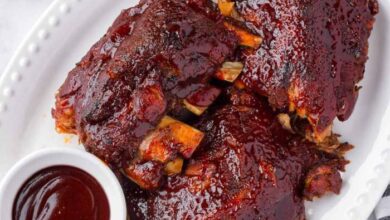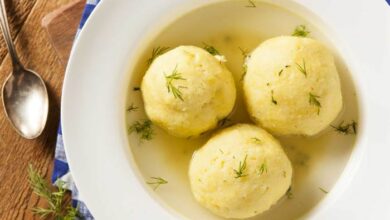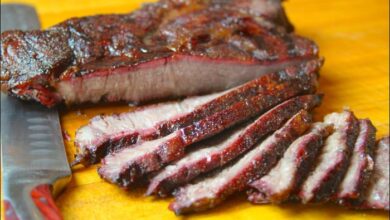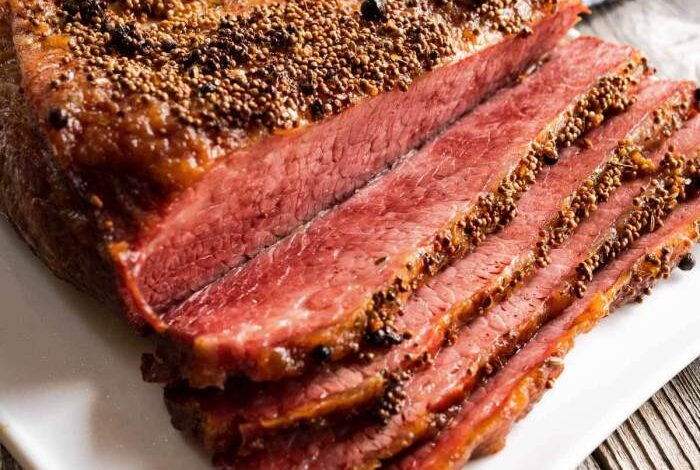
Braised Corned Beef Brisket: A Culinary Journey
Braised corned beef brisket is a dish steeped in history and tradition, a culinary journey that transports us through generations of flavors and cultures. Its origins can be traced back to the 19th century, when Irish immigrants brought their beloved recipe to the United States.
This hearty dish quickly became a staple in many American households, particularly in Jewish communities, where it was often served on special occasions and holidays.
The preparation of braised corned beef brisket involves a meticulous process of brining, curing, and slow-cooking, resulting in a tender, flavorful, and incredibly satisfying meal. The rich, savory flavors of the brisket are enhanced by the addition of spices, herbs, and vegetables, creating a symphony of taste that tantalizes the palate.
From classic recipes to innovative interpretations, braised corned beef brisket continues to capture the hearts and stomachs of food enthusiasts around the world.
History and Origins
Corned beef brisket, a beloved staple in many cuisines, boasts a rich history that spans centuries and continents. Its journey from humble beginnings to culinary icon is a testament to the ingenuity of food preservation techniques and the enduring appeal of flavorful, affordable meals.
The Origins of Corned Beef
The origins of corned beef can be traced back to the 17th century in Ireland, where salt was used as a primary method of preserving meat. This practice was particularly important for coastal communities, where access to fresh meat was limited.
The term “corned” derives from the practice of using large grains of salt, known as “corns” of salt, to cure the meat. This process not only extended the shelf life of the beef but also imparted a distinctive salty flavor.
Ingredients and Preparation
Braising corned beef brisket requires a few key ingredients and some preparation to ensure a tender and flavorful result. This involves understanding the process of brining or curing, which imparts the distinctive flavor profile of corned beef.
Brining or Curing Corned Beef Brisket
Brining is a crucial step in preparing corned beef brisket. It involves soaking the brisket in a salt-based solution, which helps to preserve the meat and enhance its flavor. The brining process typically uses a mixture of salt, sugar, spices, and sometimes curing salts like sodium nitrite or potassium nitrate.
- Salt: The primary ingredient in brining, salt draws moisture out of the meat, helping to preserve it and create a flavorful brine.
- Sugar: Sugar balances the saltiness of the brine and contributes to the final flavor of the corned beef.
- Spices: Spices like black peppercorns, coriander seeds, and bay leaves add complexity and depth to the flavor of the corned beef.
- Curing Salts: These salts, such as sodium nitrite or potassium nitrate, are optional but are used to enhance the preservation process and give the corned beef its characteristic pink color.
The brining process typically takes several days, allowing the salt and spices to penetrate the meat thoroughly. This process imparts a salty and savory flavor profile, and the brisket will be ready for braising after the brining period.
Preparing the Brisket for Braising
Once the brisket has been brined, it’s essential to prepare it for braising. This involves removing excess moisture and seasoning the brisket to enhance its flavor.
- Rinse the brisket: Rinse the brisket thoroughly under cold running water to remove any excess salt and spices.
- Pat dry the brisket: Use paper towels to pat the brisket dry. This helps to prevent steam from forming during braising, which can make the meat less tender.
- Season the brisket: After patting dry, season the brisket generously with black pepper, garlic powder, onion powder, and paprika. You can also add other spices like smoked paprika or chili powder to enhance the flavor.
Proper preparation ensures the brisket absorbs the flavors of the braising liquid and cooks evenly, resulting in a tender and flavorful dish.
Braising Techniques
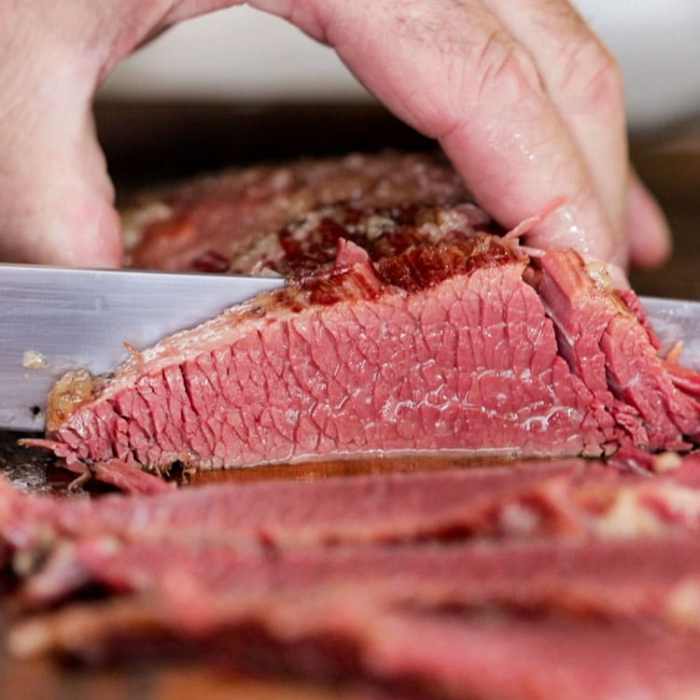
Braising is a quintessential cooking method for corned beef brisket, allowing the tough cuts to become incredibly tender and flavorful. This gentle cooking process involves searing the meat to create a flavorful crust, then simmering it in a flavorful liquid until it reaches fork-tender perfection.
Importance of Slow Cooking and Moisture Retention
The key to successful braising lies in slow cooking and moisture retention. The low and slow heat allows the collagen in the brisket to break down, transforming it into gelatin, which adds richness and tenderness to the meat. The liquid bath provides a moist environment that prevents the brisket from drying out, ensuring a juicy and succulent final product.
Techniques for Achieving Tender and Flavorful Brisket
Using a Dutch Oven
A Dutch oven is an ideal vessel for braising corned beef brisket. Its heavy construction distributes heat evenly, and its tight-fitting lid helps to retain moisture during the long cooking process.
Using a Slow Cooker
Slow cookers excel at braising corned beef brisket due to their ability to maintain a low and consistent temperature for extended periods. This allows the meat to cook slowly and evenly, resulting in incredibly tender and flavorful brisket.
Braised corned beef brisket is a classic dish that always brings comfort and warmth to the table. The slow cooking process allows the flavors to meld and create a truly satisfying meal. If you’re looking for a hearty and delicious way to use leftover corned beef, consider making a instant pot beef and vegetable soup.
The rich beef broth and tender corned beef chunks will make for a flavorful and satisfying soup. Of course, you can also use the leftover corned beef in sandwiches or hash, but a hearty soup is always a welcome option.
Using a Pressure Cooker
While not a traditional braising method, pressure cookers can be used to braise corned beef brisket in a fraction of the time. The high pressure and steam create a moist environment that quickly breaks down the collagen in the meat, resulting in tender and flavorful brisket.
Tips for Achieving Tender and Flavorful Brisket
- Sear the brisket thoroughly:Before braising, sear the brisket on all sides over high heat to develop a flavorful crust. This creates a barrier that helps to retain moisture during cooking.
- Use a flavorful braising liquid:The braising liquid plays a crucial role in infusing the brisket with flavor. Use a combination of broth, beer, wine, or even water with aromatics like onions, garlic, carrots, and bay leaves.
- Maintain a low and slow cooking temperature:Braising should be done at a low temperature, typically between 275°F and 325°F (135°C to 160°C). This allows the collagen to break down slowly and evenly, resulting in tender brisket.
- Cook until the brisket is fork-tender:The brisket is ready when it is fork-tender and pulls apart easily. This can take several hours, depending on the size and thickness of the brisket.
Flavor Profiles and Variations
The beauty of braised corned beef brisket lies in its versatility, allowing for a wide range of flavor profiles to suit different palates and culinary preferences. From classic to contemporary, there’s a braised corned beef brisket recipe to satisfy every craving.
Spices, herbs, and other flavor enhancers play a crucial role in shaping the final taste of the dish. These ingredients can be used individually or in combination to create complex and nuanced flavor profiles.
Spices and Herbs
Spices and herbs are essential for adding depth and complexity to the flavor of braised corned beef brisket. They can be used in various combinations to create unique flavor profiles.
- Classic:The classic corned beef brisket flavor profile is characterized by the use of black peppercorns, bay leaves, allspice berries, and coriander seeds. These spices create a warm and savory flavor that complements the richness of the beef.
- Smoky:For a smoky flavor profile, smoked paprika, chipotle powder, or smoked garlic powder can be added to the braising liquid. These spices impart a smoky aroma and flavor that enhances the overall taste of the dish.
- Spicy:For a spicy kick, red pepper flakes, cayenne pepper, or habanero peppers can be added to the braising liquid. These ingredients add a touch of heat that balances the richness of the beef.
- Herbs:Fresh herbs like thyme, rosemary, and parsley can be added to the braising liquid or sprinkled over the finished dish. These herbs add a fresh and aromatic element to the flavor profile.
Regional Adaptations
Regional variations in braised corned beef brisket recipes often reflect the local culinary traditions and ingredients available.
Braised corned beef brisket is a classic comfort food, and while it’s rich and flavorful, it’s often paired with simple sides. For a touch of sweetness, I love to serve it with a side of peanut butter balls iii – they’re the perfect complement to the savory beef.
The creamy peanut butter and the crispy, salty brisket create a delicious contrast in textures and flavors.
- New York:New York-style corned beef brisket is typically braised with a simple mixture of black peppercorns, bay leaves, and allspice berries. The brisket is then thinly sliced and served on rye bread with mustard.
- Texas:Texas-style corned beef brisket often incorporates a smoky flavor profile, using ingredients like smoked paprika, chipotle powder, or smoked garlic powder. The brisket is typically served with barbecue sauce and sides like coleslaw and potato salad.
- Caribbean:Caribbean-style corned beef brisket often features a blend of spices like cumin, coriander, turmeric, and allspice. The brisket is typically braised with a combination of beer, rum, and spices, resulting in a flavorful and aromatic dish.
Popular Variations
Beyond regional adaptations, there are numerous popular variations of braised corned beef brisket.
- Bourbon Braised:A touch of bourbon whiskey adds a rich and complex flavor to the braising liquid, complementing the savory notes of the beef. The bourbon can be added at the beginning of the braising process or used to deglaze the pan after the brisket is removed.
- Coffee Braised:Coffee can be used to add a unique and slightly bitter flavor to the braising liquid. The coffee can be added to the braising liquid with other spices or used to make a coffee glaze for the finished brisket.
- Honey Glazed:A honey glaze can be added to the brisket during the last hour of braising to create a sweet and savory flavor profile. The glaze can be made with honey, soy sauce, and a touch of ginger.
Serving Suggestions and Pairings
Braised corned beef brisket, with its rich flavor and tender texture, lends itself to a variety of serving styles and pairings. Whether you’re looking for a classic presentation or a more modern approach, there’s a way to enjoy this dish that will suit your taste.
Traditional Serving Styles
Traditional methods of serving braised corned beef brisket often emphasize its hearty and comforting qualities.
- Sliced and Served with Sides:The most common method involves slicing the brisket thinly against the grain and serving it alongside classic accompaniments. This allows for the full flavor of the brisket to shine through while also providing a satisfying meal.
- Reuben Sandwiches:A beloved classic, Reuben sandwiches feature corned beef brisket piled high on rye bread with sauerkraut, Swiss cheese, and Thousand Island dressing. This combination creates a symphony of flavors and textures that is truly satisfying.
- Hash:Corned beef hash is a hearty and flavorful dish made with diced corned beef brisket, potatoes, and onions. It can be served for breakfast, lunch, or dinner, and is often topped with a fried egg.
Innovative Serving Styles, Braised corned beef brisket
While traditional methods are always popular, there are also many innovative ways to serve braised corned beef brisket.
- Tacos:Shredded corned beef brisket can be used to create flavorful and satisfying tacos. Top the tacos with your favorite toppings, such as salsa, guacamole, and sour cream.
- Salads:Corned beef brisket can add a savory element to salads. Try adding sliced brisket to a salad with greens, vegetables, and a tangy dressing.
- Pasta Dishes:Corned beef brisket can be incorporated into pasta dishes for a unique and flavorful twist.
Side Dishes and Accompaniments
The best side dishes for braised corned beef brisket complement its rich flavor and savory profile.
- Classic Accompaniments:Traditional sides like mashed potatoes, steamed cabbage, and boiled carrots offer a comforting and familiar pairing.
- Modern Pairings:For a more contemporary twist, try pairing the brisket with roasted root vegetables, such as parsnips, turnips, or sweet potatoes.
- Sauerkraut:Sauerkraut is a traditional accompaniment to corned beef brisket, adding a tangy and slightly acidic note that balances the richness of the meat.
Beverage Pairings
The right beverage can enhance the enjoyment of braised corned beef brisket.
- Beer:A crisp lager or a robust stout can complement the savory flavors of the brisket.
- Wine:A full-bodied red wine, such as Cabernet Sauvignon or Merlot, can stand up to the richness of the meat.
- Non-Alcoholic Beverages:For a refreshing alternative, try pairing the brisket with a cold glass of iced tea or lemonade.
Nutritional Considerations
Braised corned beef brisket, a hearty and flavorful dish, offers a unique nutritional profile. While it can be a satisfying meal, it’s essential to understand its nutritional content and consider its potential health implications.
Nutritional Breakdown
A typical serving of braised corned beef brisket (approximately 3 ounces) provides a significant amount of protein, along with moderate amounts of fat and sodium.
- Protein:Corned beef brisket is a good source of protein, providing about 20 grams per serving. Protein is essential for building and repairing tissues, maintaining muscle mass, and supporting a healthy immune system.
- Fat:While corned beef brisket contains fat, the type of fat depends on the cut and preparation method. It can be a source of both saturated and unsaturated fats. It’s important to note that the braising process can help reduce the amount of saturated fat in the meat.
- Sodium:Corned beef is naturally high in sodium due to the curing process. A single serving can contain up to 1,000 mg of sodium, which is about half of the daily recommended intake for most adults.
Health Benefits
While corned beef brisket is high in sodium, it offers some potential health benefits.
Braised corned beef brisket is a classic comfort food that’s perfect for a chilly evening. The slow cooking process allows the flavors to meld and the meat to become incredibly tender. For a delicious side dish, I love to make a creamy, cheesy slow cooker creamed corn that’s both sweet and savory.
The combination of the rich, flavorful brisket and the creamy corn is simply irresistible.
- Protein Source:As a good source of protein, it can help maintain muscle mass, especially for individuals who are physically active or trying to lose weight.
- Iron:Corned beef brisket is a good source of iron, which is essential for carrying oxygen throughout the body.
- Vitamin B12:This meat also provides a significant amount of vitamin B12, crucial for the formation of red blood cells and the maintenance of a healthy nervous system.
Potential Drawbacks
The high sodium content of corned beef brisket is a significant concern for individuals with high blood pressure or other health conditions.
- High Sodium:Excessive sodium intake can contribute to high blood pressure, heart disease, and stroke.
- Saturated Fat:While braising can reduce the amount of saturated fat, it’s still a significant contributor to unhealthy cholesterol levels, increasing the risk of heart disease.
Healthier Variations
To mitigate the potential health drawbacks, consider these tips for making healthier variations of braised corned beef brisket:
- Choose a Leaner Cut:Opt for a leaner cut of brisket, such as the flat cut, which typically has less fat than the point cut.
- Trim Excess Fat:Before braising, trim off any visible fat from the brisket.
- Reduce Sodium:Use a low-sodium corned beef brisket or reduce the amount of salt added during the braising process.
- Substitute Broth:Instead of using a high-sodium broth, use a low-sodium broth or even water for braising.
- Balance the Meal:Pair the corned beef brisket with plenty of vegetables and whole grains to create a balanced meal with a lower sodium and fat content.
Cultural Significance and Traditions
Corned beef brisket holds a special place in the hearts and kitchens of many cultures around the world, reflecting a rich tapestry of history, tradition, and culinary ingenuity. Its journey from humble origins to a beloved staple has woven itself into the fabric of various communities, creating unique customs and celebrations that continue to this day.
Jewish Heritage and Tradition
Corned beef brisket is deeply intertwined with Jewish culinary traditions, particularly within Ashkenazi Jewish culture. Its roots can be traced back to Eastern Europe, where salt-cured meats were a vital source of protein in regions with limited access to refrigeration.
The salting process not only preserved the meat but also added a distinctive flavor that became a hallmark of Ashkenazi cuisine.
“Corned beef brisket is more than just a dish; it’s a symbol of resilience, resourcefulness, and cultural identity.”
The dish gained prominence in the United States during the late 19th and early 20th centuries, as Jewish immigrants from Eastern Europe settled in cities like New York, where delis became a central part of their social and cultural life.
Corned beef sandwiches, often served on rye bread with mustard, became a signature item in these delis, representing both a nostalgic connection to their heritage and a symbol of their newfound American identity.
Irish-American Cuisine
While corned beef brisket is often associated with Jewish cuisine, it also holds a significant place in Irish-American culinary traditions. The use of corned beef in Irish-American cooking is believed to have originated during the Great Famine in Ireland (1845-1849), when many Irish immigrants arrived in the United States seeking a better life.
- The immigrants brought with them their culinary traditions, including the use of salted meats, and adapted these practices to the ingredients and resources available in their new home.
- Corned beef, being a readily available and affordable option, became a staple in Irish-American kitchens, often served with cabbage and potatoes, reflecting a combination of Irish and American culinary influences.
The association of corned beef with St. Patrick’s Day celebrations is a testament to its enduring presence in Irish-American culture. While the origins of this association are not definitively established, it is believed to have emerged from the Irish immigrants’ desire to celebrate their heritage and create a sense of community in their new land.
Recipe Variations and Innovations
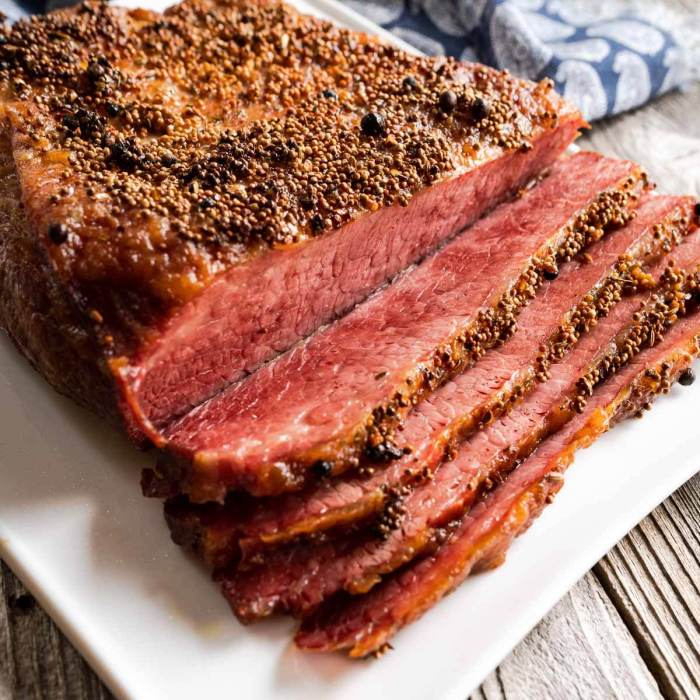
The classic braised corned beef brisket recipe can be adapted in countless ways, offering a canvas for culinary creativity. From subtle tweaks to bold reinventions, these variations cater to diverse palates and culinary preferences.
Variations in Ingredients and Techniques
The versatility of corned beef brisket allows for experimentation with various ingredients and cooking methods. Here’s a table showcasing different recipe variations:
| Variation | Ingredients | Cooking Method | Flavor Profile |
|---|---|---|---|
| Classic Braised Corned Beef Brisket | Corned beef brisket, onions, carrots, celery, water, beer, bay leaves, peppercorns | Braised in liquid | Savory, salty, slightly sweet |
| Spicy Braised Corned Beef Brisket | Classic ingredients + jalapeños, habanero peppers, chipotle powder | Braised in liquid | Savory, salty, spicy |
| Bourbon Braised Corned Beef Brisket | Classic ingredients + bourbon whiskey | Braised in liquid | Savory, salty, smoky, hint of sweetness |
| Slow Cooker Corned Beef Brisket | Classic ingredients | Slow cooked in a slow cooker | Tender, flavorful, melt-in-your-mouth |
| Smoked Corned Beef Brisket | Corned beef brisket | Smoked over wood chips | Savory, smoky, slightly sweet |
Modern Interpretations of Corned Beef Brisket
Modern chefs are reimagining the traditional corned beef brisket dish with innovative techniques and flavor combinations. Some examples include:
Corned Beef Brisket Tacos
This popular street food adaptation features thinly sliced braised corned beef brisket served in warm tortillas with toppings like pico de gallo, guacamole, and sour cream.
Corned Beef Brisket Hash
A modern twist on the classic hash, this dish incorporates braised corned beef brisket with roasted potatoes, onions, and peppers.
Corned Beef Brisket Pizza
This creative pizza topping uses braised corned beef brisket as the main ingredient, paired with melted cheese, caramelized onions, and a tangy mustard sauce.
Corned Beef Brisket Pastrami
This innovative interpretation uses braised corned beef brisket as the base for a pastrami-style sandwich, cured and smoked to achieve a distinctive flavor.These examples demonstrate the potential for culinary innovation with corned beef brisket, showcasing the dish’s adaptability to contemporary tastes and trends.
Culinary Techniques and Tips
Braising corned beef brisket is a time-honored technique that yields incredibly tender and flavorful results. It involves a combination of methods, each contributing to the final product’s success. This section delves into the key techniques and offers tips for optimizing the braising process.
Sealing and Browning
Sealing the brisket before braising is crucial for developing a rich crust and locking in moisture. The Maillard reaction, a chemical process that occurs at high temperatures, is responsible for the browning and flavor development.
- To seal the brisket, heat a large skillet or Dutch oven over medium-high heat. Add a tablespoon or two of oil, ensuring the pan is adequately coated.
- Place the brisket in the hot pan, ensuring it fits comfortably. Cook for 3-5 minutes per side, until a deep golden-brown crust forms.
- Avoid overcrowding the pan, as this can lower the temperature and prevent proper browning. If necessary, brown the brisket in batches.
Braising Liquid
The braising liquid plays a vital role in infusing flavor and tenderizing the brisket. A combination of liquids, often including beer, broth, or wine, is used to create a flavorful base for the braising process.
- The braising liquid should cover the brisket by at least half its height. This ensures even cooking and prevents the brisket from drying out.
- Adding aromatics like onions, carrots, celery, garlic, and bay leaves enhances the flavor profile of the braising liquid.
- Adjust the seasoning according to taste. Salt, pepper, and other spices are commonly used to complement the corned beef’s flavor.
Slow and Low Cooking
The braising process involves cooking the brisket in a liquid at a low temperature for an extended period. This gentle heat allows the collagen in the brisket to break down, resulting in a tender and succulent texture.
- Braising temperatures typically range from 275°F to 325°F (135°C to 160°C). This low temperature ensures the brisket cooks slowly and evenly.
- The braising time can vary depending on the size of the brisket, but it generally takes 3-4 hours for a 3-4 pound brisket.
- Monitor the braising liquid levels and add more if necessary to prevent the brisket from drying out.
Resting and Slicing
After braising, allow the brisket to rest for at least 30 minutes before slicing. This resting period allows the juices to redistribute throughout the meat, resulting in a more tender and flavorful final product.
- Transfer the brisket to a cutting board and cover it loosely with aluminum foil. Allow it to rest for at least 30 minutes.
- Slice the brisket against the grain, resulting in tender and easily chewable slices.
- Use a sharp knife for clean and precise slicing.
Visual Representation: Braised Corned Beef Brisket
Braised corned beef brisket, a culinary masterpiece, is not only a feast for the palate but also a delight for the eyes. Its rich color, tender texture, and captivating presentation make it a visually appealing dish.
Visual Appeal
The visual appeal of braised corned beef brisket stems from its deep, rich color, tender texture, and artful presentation. The meat, after being slow-cooked, develops a deep mahogany hue, hinting at the flavorful journey it has undergone. The brisket’s surface is often glistening with a layer of rendered fat, adding to its visual appeal.
The meat itself is incredibly tender, falling apart at the slightest touch, making it a pleasure to behold.
Presentation
Braised corned beef brisket can be presented in various ways, each contributing to its visual appeal. It can be served as a centerpiece on a platter, sliced and fanned out, showcasing its succulent texture and inviting aroma. The brisket can also be served on a bed of creamy mashed potatoes, its deep color contrasting beautifully with the white background.
Another popular presentation is to serve it with a side of tangy sauerkraut, providing a visual contrast of textures and colors.


